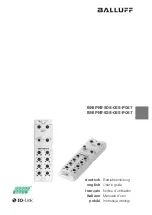
completely different than the
capacitive
(short duration charge at higher-than-battery voltage) charging
method used by several other aftermarket manufacturers. What may work well for these systems may not
work well for ours. Following our recommendations about spark plug and wire selections will yield
excellent results.
D. Fuel Injector Configurations
D.1. High vs. Low Impedance Injectors
The
TECgt
is equipped with 6 fuel injector channels. These channels are pull-to-ground outputs,
meaning that they provide a ground connection for the injectors when they fire.
The injector channels can be configured to run in one of two modes – either 2 amps peak with 0.5
amps hold for one low impedance injector per channel or 4 amps peak with 1 amp hold for a pair of low
impedance injectors per channel.
To differentiate between high and low impedance injectors, simply measure the resistance across
the two terminals on the injector. If the resistance is around 2.5 ohms, it is a low impedance injector. If the
resistance is around 1.2 ohms, it is a throttle body-style injector. If the resistance is above 12 ohms, it is a
high impedance injector.
Low resistance injectors are used when the injector is large and finer control of the low opening
time is required. Most OEM injectors are smaller and are of the high resistance type.
When selecting your output from the 4/1 or 2/0.5 type you should match the output to your injector
configuration. (see
Figure D.1. 1
for parallel wiring instructions).
As a rule, always use the 4 amp setting for running injectors in pairs.
Use the 2 amp setting to run injectors individually one per driver.
The one exception to this rule would be the 1.2ohm injectors found in throttle body injection
(TBI) setups. These injectors should be wired with only one injector per driver
in the 4amp mode.
High impedance injectors can be used in place of low impedance injectors at any time, as a rule, use
the same logic to adjust your outputs.
When the injectors are wired such that the circuit will flow more than 5 amps, the
TECgt
fires them
in
peak-and-hold
mode. When this is happening, the injector current ramps up to approximately 4 amps
very quickly, then drops to 1 amp for the remainder of the pulse width. See
Figure D.1. 2
for details on
peak-and-hold mode.
When an injector circuit is wired so that the circuit will flow less than 2amps, the injectors will be
fired in
saturation
mode. When this happens, the injectors will ramp up to the maximum amperage
determined by the circuit (should be less than 2amps), and keep the current at this level for the remainder of
the pulse width.
The bottom line here is that the injector channels should never be required to remain turned on (in
“hold-mode”) at a level greater than 2 amps. As long as the circuit is capable of flowing more than ~ 5
amps, the
TECgt
will enter peak-and-hold mode, thus limiting the current output. Care must be taken
when using injector circuits that flow less than 5amps, since they will not engage the peak-and-hold mode.
As a result, the injector channels will remain on full current for the entire pulse width. Also, if a low
impedance injector resistance measures less than 2.2ohms when cold, its resistance may increase when
warm, so it should not be used on a one-injector-per-driver basis. With these points in mind, use
Table
D.1. 1
to determine the correct fuel injector type for your application.
______________________________________________________________________________________
TECgt Manual Version 2.0
- Page 50 -
©2008 Electromotive, Inc.
















































